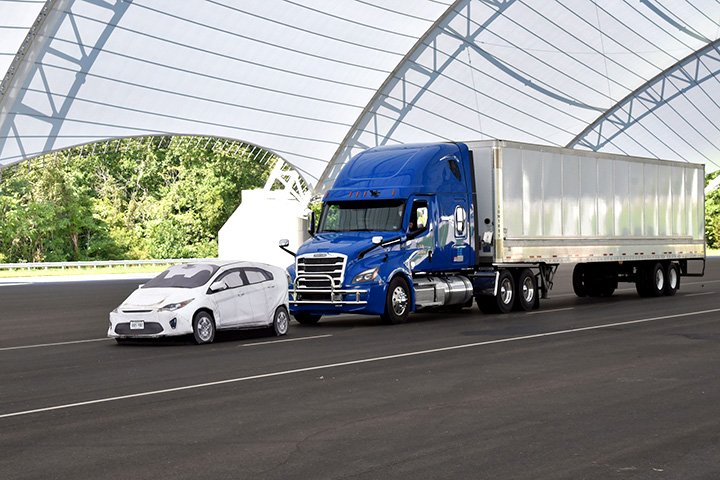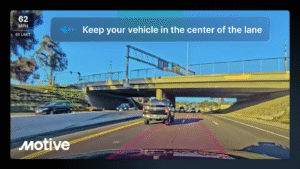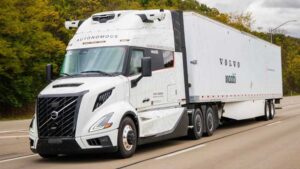WASHINGTON — The White House is now reviewing a National Highway Traffic Safety Administration (NHTSA) proposal to require automatic emergency braking (AEB) systems on heavy trucks.
The president’s office has to approve the proposal before it can be published in the Federal Register, where it will receive public comment before regulators decide whether it should become law.
“This joint rulemaking of the NHTSA and Federal Motor Carrier administration will be seeking comments on a proposal to require and/or standardize equipment performance for AEB systems on heavy trucks (2127-AM36),” a federal report filed with the Office of Information and Regulatory Affairs notes. “The rulemaking is expected to propose performance standards and motor carrier maintenance requirements for AEB systems on heavy trucks and accompanying test procedures for measuring the performance of the AEB systems in NHTSA compliance testing.”
The Insurance Institute for Highway Safety (IIHS), a research group supported by auto insurers, found in a 2020 study that automatic emergency braking and forward collision warnings could prevent more than 40% of crashes in which semis rear-end other vehicles.
A study by the group found that when rear crashes happened, the systems cut speeds by more than half, reducing damage and injuries.
NHTSA had proposed a regulation on automatic emergency braking in 2015, but it languished in the regulatory process.
In 2016, NHTSA brokered a deal with 20 automakers representing 99% of U.S. new passenger vehicle sales to voluntarily make automatic emergency braking standard on all models by Sept. 1, 2022.
But that deal did not apply to big rigs.
The Owner-Operator Independent Drivers Association, in its publication LandLine, recently quoted OOIDA’s director of federal affairs Jay Grimes on the issue.
“We certainly have concerns about AEB technology and how it will work in certain driving conditions, most notably at night,” Grimes said. “We want to make sure these systems are not giving off false alarms and false detections that distract drivers and take the control out of their hands.”
IIHS STUDY
Equipping large trucks with forward collision warning and AEB systems could eliminate more than two out of five crashes in which a large truck rear-ends another vehicle, according to the IIHS study.
Eric Teoh, director of statistical services for IIHS, examined data on crashes per vehicle mile traveled from 62 carriers operating tractor-trailers and other trucks weighing at least 33,000 pounds.
He found that trucks equipped with forward collision warning had 22% fewer crashes, while trucks with AEB had 12% fewer crashes than those without either technology. Forward collision warning and AEB reduced rear-end crashes, the specific type of collision they’re designed to prevent, by 44% and 41%, respectively.
Although drivers of large trucks crash less often per mile traveled, these trucks can be especially deadly because they can weigh 20 to 30 times as much as passenger vehicles. U.S. crashes involving large trucks have risen by nearly a third since hitting an all-time low in 2009, with 4,136 people killed in 2018. Among those fatalities, 119 deaths resulted from large trucks rear-ending passenger vehicles.
Overall, Teoh’s study covered about 2,000 crashes that occurred over more than 2 billion vehicle miles traveled during 2017-2019. The analysis excluded incidents that weren’t serious enough to result in injury or significant property damage.
“This study provides evidence that forward collision warning and AEB greatly reduce crash risk for tractor-trailers and other large trucks,” Teoh said. “That’s important information for trucking companies and drivers who are weighing the costs and benefits of these options on their next vehicles.”
Front crash prevention systems use cameras, radar or other sensors to monitor the roadway ahead. Some include only forward collision warning, which alerts the driver to obstacles in the roadway. AEB systems go further, automatically applying the brakes to prevent the collision or reduce its severity. The European Union has required AEB with forward collision warning on most new heavy trucks since November 2013.
The number of large trucks equipped with AEB is increasing, but there have been few studies of its effect on crash rates.
In the large-truck study, Teoh compared trucks from the same carriers that were equipped with forward collision warning alone, AEB and no front crash prevention at all (AEB systems generally include forward collision warning too).
For the first time, the IIHS drew on data compiled by SmartDrive Systems, a video-based safety program for commercial fleets. SmartDrive was able to determine which trucks were equipped with forward collision warning and AEB and collect detailed information about crashes. Using data collected by a third party helped to minimize data differences among carriers that might have influenced the results.
The similar benefits of forward collision warning and AEB that Teoh observed for rear-end crashes were unexpected, since studies of passenger vehicles have shown AEB to be much more effective than systems that only issue warnings. These findings could reflect differences in how and by whom trucks and passenger vehicles are driven; or the differences could be connected to variations among the specific systems used by each carrier.
The study indicated that AEB and forward collision warning are both likely to have benefits beyond the reduction in crashes. Some crashes that aren’t prevented by the systems are made less severe, thanks to a reduction in impact speed. This is true whether it’s the automated system applying the brakes or a human driver who has more time to react because of a warning.
In reviewing the trucks that rear-ended other vehicles, Teoh found that either system resulted in speed reductions of more than 50% between the warning or automatic braking and the impact.
“The potential benefits are great enough that these crash avoidance systems should be standard equipment on all new large trucks,” said IIHS President David Harkey.
The Trucker News Staff produces engaging content for not only TheTrucker.com, but also The Trucker Newspaper, which has been serving the trucking industry for more than 30 years. With a focus on drivers, the Trucker News Staff aims to provide relevant, objective content pertaining to the trucking segment of the transportation industry. The Trucker News Staff is based in Little Rock, Arkansas.















Well let me tell you this National Highway Safety Administration. You are focusing to much on the truck and the drivers just as the Federal Motor Carrier Safety Awareness are.
The problem is your out of date highway signs. Do you realize that you have in most states the signs that say “no trucks in left lane”. Are you aware that you are putting a wall of trucks in the center lane and the right lane and therefore you have vehicles merginging on to the highway and lets not forget that you have vehicles trying to exit at the same time. HHHmmm and what do they have to do??? GO THROUGH A WALL OF TRUCKS DUUHH!!! Do you know how many times as a 20 year Professional Truck Driver (with no violations) that I have witnessed a vehicle go from the fast lane and jump to the middle lane and hit their brakes to jump in the line of exiting traffic in the right lane. More time than I wish to remember because guess what vehicle they slammed on their brakes in front of (A BIG ASS TRUCK WEIGHING 80,000 LBS MINDING HIS OWN BUSINESS AND GOING WITH THE FLOW OF TRAFFIC OR EVEN SLOWER BECAUSE OF VEHICLES HE IS EXPECTING TO DO THAT.) These are the vehicles that are getting rear ended because they do not have a clue.
With all of this being said!!!!
WHY HAS THE FMCSA AND NHTSA FAILED TO REALIZE THAT THE PROBLEM IS YOUR TRAFFIC SIGNS?
WHY DO YOU WANT TRUCKS IN THE RIGHT LANE OR MIDDLE LANE IF THEY ARE GOING THROUGH YOUR CITY?
wHY DO YOU WANT A WALL OF 18 WHEELERS FOR THE REGULAR VEHICLES TO GET THROUGH?
WHY HAVE YOU NOT ENFORCED MORE TRAINING FOR REGULAR DRIVERS LICENSED PEOPLE TO REALIZE WHAT IT IS LIKE TO DRIVE A HEAVY VEHICLE?
WHY IS THE ONLY FOCUS ON COMMERCIAL VEHICLES?
You have done everything possible to the driver with the rules and regulations.
Don’t you think it is time to take another look at what the real problem is and that is what I have shared with you.
IT IS TIME TO WAKE UP AND DO SOMETHING!!!!
THE PROBLEM IN NOT SAVING LIVES AND PREVENTING ACCIDENTS IS THE LAWS OF TRAFFIC SIGNS AND NOT THE COMMERCIAL DRIVER. WHY DON,T YOU LET ME GO TO WORK FOR YOU OR THE FMSCA AND TAKE SURVEYS FROM AROUND THE COUNTRY IN HEAVY ACCIDENT AND DEATH FROM CRASHS AREAS WITH THE HIGHWAY PATROL AND I PROMISE YOU THAT THE INFORMATION FROM THE HIGHWAY PATROL OFFICERS WILL BE AS I AM TELLING YOU THE PROBLEM. GIVE ME A CHANCE AND I WILL PROVE IT WITH THE HELP OF MY FELLOW OFFICERS. WHAT DO YOU HAVE TO LOSE? OH YEA MORE LIVES RIGHT. LET,S DO SOMETHING ABOUT THIS AND TAKE OUR FOCUS OFF OF THE PEOPLE WHO PUT FOOD ON YOUR TABLE. THINK ABOUT IT?
IF IT WAS NOT FOR TRUCKS YOU WOULD BE HOMELESS, HUNGRY, AND NAKED.
JOHN MIZELL
(316) 351-2979
[email protected]
Thankyou
Because the rule makers sit behind a desk and have never experienced the crap that goes on out here. I’m ready to hang my hat, between the asshole drivers, the forever changing rules, and the dummies they hire to enforce the regulations its just mind boggling how inefficient the whole system is.
Now Congress wants to rewards new CDL drivers with Tax Breaks, WTF? What about everyone that worked through Covid, where is anything for us?
The above is so right I have out there for over 30 years seen a lot there are people making these laws that appear not to know to much about trucks a few years ago a company I was driving for bought new trucks they had this automatic braking system on them, at that time DOT knew about the system but did not approve it, it was in the winter time, I was on ice and of course a car pulled out right in front of me I was on ice traveling about 4mph the brakes sensed the car and brakes were applied and away I went sliding all over the place the car lost it and went in the ditch I was trying to keep my truck on the road but I was heading towards the river, but thankfully I hit a dry spot and was able to stop, now these things you people put on these trucks don’t know what kind of road conditions we are on, so you put all of us in danger and when something happens it’s automatically the drivers fault, if the driver dies than nobody will know that the real people at fault was our government and FMSCA but believe me you people will just try and cover things up, but you all just keep treating truck drivers like they are trash, and keep hiring more kids and put them on the road, unaware of what to do in a situation
What happens when the sensor for the device wrongly senses a vehicle right smack in front you out of the blue when there is no vehicle right smack in front of you and slams on the brakes when you are doing 70mph like it does occasionally on the truck that I drive? And what would happen if that thing did that when the roads were slippery wet or icy when it did that? And maybe like actually cause a deadly accident instead of prevent one? Fortunately the roads have been dry the times that it has happened on my truck. I gaurantee the video clip from the driver facing camera would mysteriously get accidently deleted so that the carrier or truck manufacturer would avoid a million dollar libel suit.
is the problem the trucks or the cars that cut in front of them and hit their brakes taking away stopping distance from the truck driver…how about making car drivers more aware of what’s going on around them outside of their cars